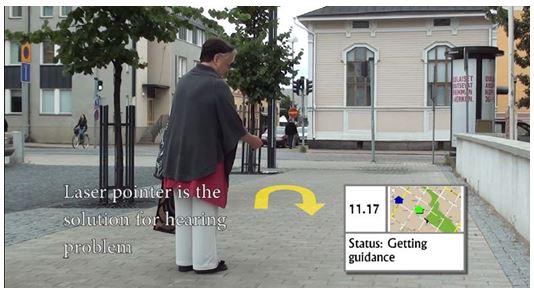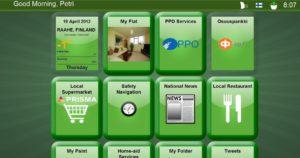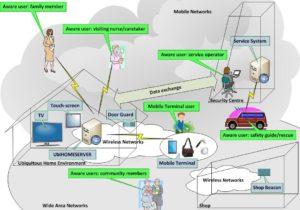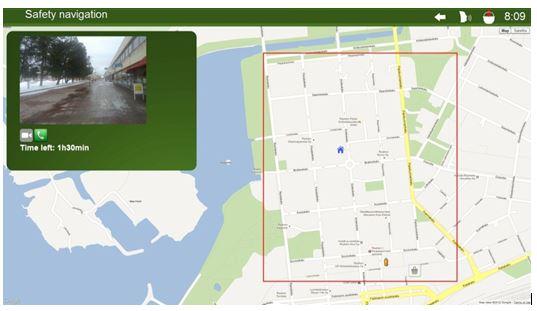Introduction
Societies in Finland and Japan are aging at an alarming rate [7, 8]. As the structure of the population is shifting towards the elderly, studies have shown that Finland is facing a crisis when the cost of supporting the elderly rises and the amount of caretakers is not sufficient enough for support [2].
The numbers of elderly who live alone grows and the older they get, the more assistance they require [3]. The amount of elderly people, suffering from varying memory impairments, is also going to more than double during the next 30 years [1]. If we can improve the caretaker productivity by just 1% and postpone the decline in cognitive and memory functionality of the elderly by just 5 years, the need for more caretakers plummets from near 25% to about 15% [3]. Thus accumulating vast savings accumulated for the society until the year 2040 [2].
Technological innovations have created a net of wireless information exchange between individuals with ubiquitous solutions, which could also be used to improve the quality of living for elderly. It is important to consider the availability and use of technology in different situations and to create novel solutions that meet the demands of users.
Memory problems are common for elderly and range from simple age-related problems to Alzheimer’s disease. A collaborative study in Nordic countries was made to individuals with dementia and the goal was to find out what kinds of aid devices are used, suitability for the users, and to gather improvement feedback [6]. Conclusion was that introducing aid devices improved management of daily activities, helped maintain skills and made people socially active. A study by Sorri et al. [5] has also suggested that a way finding advising technology has the potential to provide important support for the elderly by similarly motivating and empowering them to perform their daily activities.
Based on the Nordic study basic requirements for future design can be made: combine functionalities, smaller number of devices, tailor interfaces and offer tele-presence assistance. Over 40 different aid-devices were used and the median of use was a year and four months. Looking at different types of aid-devices, e.g. GPS, calendar, portable alarm and a safety camera, some existing solutions e.g. a mobile phone already combine some functions, but doesn’t offer usability designed for dementia. Reducing the number of devices is feasible, but care has to be taken in the design of the devices for the end-users. However, misplacing a device, means losing all the functionalities associated with it. Based on the feedback data, the need to learn use of new devices was constant. The degrading nature of the disease presents new problems and existing devices had to be switched to new ones. In some cases people having same severity level of dementia in similar living environments didn’t always use same devices or used them differently. Devices with tailored information would lessen the need to introduce new devices and would be familiar to the user throughout the process. Implementation of tele-guidance could provide help regardless of place and time.
Sorri et al. [5] way finding prototype was tested with real users in real environment using predefined routes. The orientation advice was given through three modalities, visual, audio and tactile signals, two of which were used at a time. Nine subjects, with a median age of 84 years, participated in the user study. Their severity of dementia ranged between mild and severe, and walking abilities ranged from “frail to hobby skier”. In addition, two elderly persons were recruited as control subjects.
In most cases, the orientation with the way finding aid on predefined routes succeeded, with a few misinterpretations. The severity of dementia didn’t seem to foretell success in orientation with the way finding aid. Finding the right door, straying from the defined route, and the attractions of real- life context like other people were challenged most the test persons. Also the correct timing of the way finding advice was found to be crucial but difficult because of the varying walking speed of the subjects. If the advice appeared too early the subjects could forget them or, alternatively, they complied with the advice literally and as a result in worst cases, turned against the wall. As against using “left”, “right” and “go straight on” commands as the way finding advice seems to be more successful than using landmarks. Confirming subjects were on the correct track turned out to be beneficial for longer legs of the routes [5].
Methods
The applicability of the approach was first evaluated in a multidisciplinary research project Value Creation in Smart Living Environment for Senior Citizen (vesc.oulu.fi) workshop. This multi- disciplinary research group used living lab approach, where technology was designed and evaluated by and in co-operation with the end-users. Smart living environment technology was designed by taking into account human-computer interaction, communication, product and services as well as human interaction. In this study focus was on testing the designed navigation system prototype with scenario-based video with actors. In the video an actor (represents end-user) tested the navigation system prototype alone and with the help of security personnel and family. Quality of Life improvement was assessed using Quality Function Deployment (QFD) framework.
Storyboard
In this study focus was on presenting a new idea of a smart navigation system for people who have mild cognitive impairment due to Alzheimer’s disease, for instance, and who often require help in their daily activities. Aim of the whole system design was to make it as simple and illustrative as possible to accommodate the needs of such people. Specifically the aim was to design the system for senior citizens. This was achieved by designing the system based on a script written in the form of a storyboard [4]. The script was first illustrated with four early storyboard designs which were presented and evaluated by the research team. Such approach was chosen to help the research team/audience better identify themselves with the main character of the scenario. According to the feedback the final 30 page storyboard was constructed and it formed the basis for the scenario video. The feedback also helped to make the video more compact and easier to understand. The storyboard was useful for the main character and other people to understand the whole concept of the safety navigation system.

Scenario video
The designed scenario video (1) features Marjatta, a 73-years old widower who lives alone. She is suffering from a mild cognitive impairment due to Alzheimer’s disease. Such characteristics were chosen for the main actor of the video, since they most likely are those observable in our end-user population. In the video we picture a typical shopping trip, representing typical activities of daily living. The trip included planning, walking from home to the shop and back. The journey contained different problems, such as choosing directions, with the possibility of the main character Marjatta being disoriented. A narrator leads the story forward. Different informative signs and guides are presented in the video which are essential for the senior citizen to comprehend the functioning of the smart navigation system but also help the viewers. The main idea of this short video was to demonstrate and describe how the possible future smart navigation system could actually work.
1 The Safety Navigation scenario video is available at: http://finplatform.pbol.org/content/InfoDayMaterials/Smart.navigation.for.senior.citizens.mp4

Implementation considerations
Safety Navigation Overview
The main purpose of the Safety Navigation system is to help elderly people in their outdoor activities that they would feel safe and secure, and to increase awareness of the situations of the elderly for those who are concerned. The objective of the system is to assist the seniors remotely utilising a variety of behavioural scenarios and modern technologies such as positioning, embedded cameras, multi-channel and multi-media communications, and laser pointers. The entire community of the Safety Navigation system consists of MoTe (Mobile Terminal) users and Aware users. Aware users are in charge or may provide help to the MoTe users.
Main Functionality and User Interfaces
The Mobile Terminal concept is developed on a base of the Android OS smartphones. Such technologies and connected frameworks were enhanced with personalized features such as addresses and safety check points. Safe areas, like the way to a bank, hospital or a store, can be also defined to the user. When the user selects a destination, the application shows the safest route for them. After departure a predefined countdown timer is activated for the user. If the time limit is exceeded, the system will notify Aware users via e.g. SMS or email message, including location, date and time, so they can take appropriate actions in order to help the MoTe user.
Ubiquitous Home Environment
Ubiquitous Home Environment (UHE) is a user-centric set of systems through which users can interact with their living environment and outside world. An essential part of the UHE is a serving engine. Typically the engine achieves interoperability with the UHE infrastructure through a variety of generic and dedicated modules. The engine should expose a number of GUIs to terminal devices.
PBOL at Oulu UAS has built an implementation of the serving engine, the UbiHOMESERVER. For sensing the physical environment, the UbiHOMESERVER interoperates with Wireless Sensor Networks (WSN) and IPTV, mobile and web channels serve for human interaction. As a core of the engine, an intelligent module was developed. Knowledge technologies, such as Semantic Web, were considered in design.
The UbiHOMESERVER offers a set of GUIs through which it is possible to interact with the UHE as well as to consume and manage the ICT Home Services. Device recognition and content adaptation technologies were used to reduce end-user GUIs’ dependencies on devices. The end-user GUIs utilise multimodal information presentation, exposing textual, symbolic, colour, sound, voice and visual modalities. The UbiHOMESERVER and GUIs are able to handle environmental changes dynamically. A grid layout was chosen for the UbiHOMESERVER GUI design. Entire interface is implemented as low-hierarchical and intuitive.

Several systems, for example the Safety Navigation System, were made interoperable with the UbiHOMESERVER and thus became integrated parts of the UHE.
Safety Navigation System Architecture
The backbone of the Safety Navigation System is the UHE. The UbiHOMESERVER is running 24/7 and serve the users of the UHE. For example, family members may share the same living environment of the MoTe users, or be connected to it remotely. Those of them, who are trusted, may also be granted access to the MoTe user’s UHE and thus use a dedicated functionality of the Safety Navigation. Security staff doesn’t not have access to MoTe user’s UHE. Instead, their systems may interoperate with the UbiHOMESERVER through dedicated interfaces.

The Mobile Terminal may be implemented in a form of a self-sufficient all-purpose device, or in a form of a distributed/interconnected set of devices. Among those may be a wearable camera, a key ring with laser pointer and a smart phone. Due to a specific target group, the Mobile Terminals must provide end-users with controls and GUIs dedicated to the use by elderly people.
The wearable camera starts to take pictures of the surrounding area when the user is considered lost. Those pictures supplement location technologies and help the Aware users to identify the position of the MoTe user more precisely.

Users may launch a live audio/video conversation, and receive guidance from the Aware users at any time. A laser pointer can be used to display a proper direction with an arrow or other symbols on a flat surface when the user is not able to use audio/video communication properly.
The door guard generates an event when the user departures from home. Safety Navigation system keeps track of such state changes by logging them with a time-stamp. The log data may be used for defining safety areas and time frames more precisely, and in the future such knowledge may bring an opportunity to develop a proactive behaviour of the system.
Acknowledgments
This work has been partly funded by the Academy of Finland and JSPS (Japan) under Smart Living Environment for Senior Citizen research projects (VESC, P-SESC) and by Tekes for Well-being Ecosystem (Ryhti) project.
Authors
Petri Pulli, Zeeshan Asghar, Mika Siitonen, Risto Niskala, Eeva Leinonen, Antti Pitkänen, Jaakko Hyry, Dept of Information Processing Science, University of Oulu, Oulu, Finland
Jarmo Lehtonen, Scope Associates Oy, Helsinki, Finland
Vadym Kramar and Markku Korhonen, (markku.korhonen@oamk.fi), Pehr Brahe Center for Industrial and Services ICT (PBOL), Oulu University of Applied Sciences, Finland
[vc_tta_accordion active_section=”0″ no_fill=”true” el_class=”lahteet”][vc_tta_section title=”References” tab_id=”1458134585005-b3f22396-5506″]
Ferri P, Prince M, Brayne C, Brodaty H, Fratiglioni L, Ganguli M, Hall K, Hasegawa K, Hendrie H, Huang Y, Jorm A, Mathers C, Menezes PR, Rimmer E, Scazufca M (2005) Global prevalence of dementia: a Delphi consensus study. Lancet 366(9503):2112-7.
Niemelä K, Salminen K (2009) Kansallisten eläkestrategioiden muotoutuminen ja Euroopan unionin avoin koordinaatiomenetelmä (in Finnish, English summary). Sosiaali- ja terveysturvan tutkimuksia No. 104. Sastamala: Vammalan Kirjapaino Oy, s. 114-136.
Parkkinen P. (2007) Riittääkö työvoima sosiaali- ja terveyspalveluihin.(in Finnish, English summary). (VATT discussion papers 433. Government Institute for Economic Research, Oy Nord Print Ab.
Siitonen (2011). Muistihäiriöisten vanhusten turvanavigointi. Oulun yliopisto
Tietojenkäsittelytieteiden laitos, pro gradu -tutkielma. 84s.
Sorri L., Leinonen E. and Ervasti M. (2011) ”Wayfinding aid for the elderly with memory disturbances”; Proceedings of the 19th European Conference on Information Systems (ECIS), ICT and Sustainable Service Development,
Tuunainen Virpi, Nandhakumar Joe, Rossi Matti and Soliman Wael (eds.), Helsinki, 2011. ISBN 978- 952-60-3574-1.
STAKES (2008) Apuvälineet ja Dementia Pohjoismaissa (in Finnish). [Web-document] http://www.stakes.fi/verkkojulkaisut/muut/M267.pdf
Statistical Handbook of Japan (2007) Statistical Research and Training Institute, MIC [Web- document] Available: http://www.stat.go.jp/english/data/handbook/c15cont.htm
Tilastokeskus (2007) Väestöennuste 2007-2040 (in Finnish). [Web-document] Available: http://www.stat.fi/til/vaenn/2007/vaenn_2007_2007-05-31_tie_001.html
[/vc_tta_section][/vc_tta_accordion]



